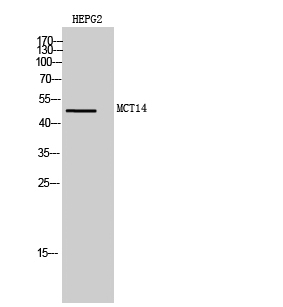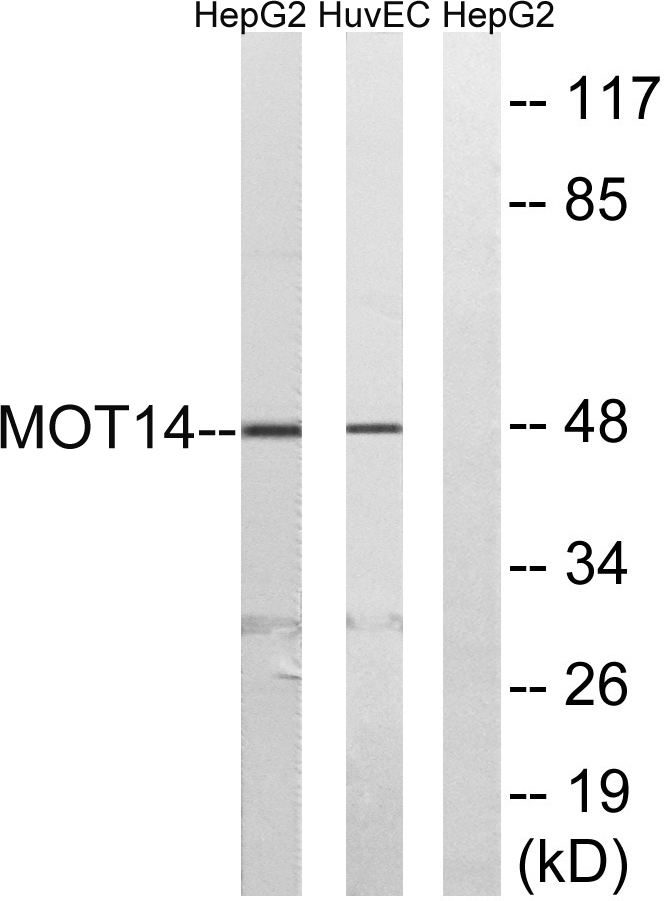MCT14 Polyclonal Antibody
- Catalog No.:YT2684
- Applications:WB;ELISA
- Reactivity:Human;Mouse
- Target:
- MCT14
- Gene Name:
- SLC16A14
- Protein Name:
- Monocarboxylate transporter 14
- Human Gene Id:
- 151473
- Human Swiss Prot No:
- Q7RTX9
- Mouse Gene Id:
- 71781
- Mouse Swiss Prot No:
- Q8K1C7
- Immunogen:
- The antiserum was produced against synthesized peptide derived from human MOT14. AA range:131-180
- Specificity:
- MCT14 Polyclonal Antibody detects endogenous levels of MCT14 protein.
- Formulation:
- Liquid in PBS containing 50% glycerol, 0.5% BSA and 0.02% sodium azide.
- Source:
- Polyclonal, Rabbit,IgG
- Dilution:
- WB 1:500 - 1:2000. ELISA: 1:10000. Not yet tested in other applications.
- Purification:
- The antibody was affinity-purified from rabbit antiserum by affinity-chromatography using epitope-specific immunogen.
- Concentration:
- 1 mg/ml
- Storage Stability:
- -15°C to -25°C/1 year(Do not lower than -25°C)
- Other Name:
- SLC16A14;MCT14;Monocarboxylate transporter 14;MCT 14;Solute carrier family 16 member 14
- Observed Band(KD):
- 48kD
- Background:
- function:Proton-linked monocarboxylate transporter. Catalyzes the rapid transport across the plasma membrane of many monocarboxylates.,similarity:Belongs to the major facilitator superfamily. Monocarboxylate porter (TC 2.A.1.13) family.,
- Function:
- function:Proton-linked monocarboxylate transporter. Catalyzes the rapid transport across the plasma membrane of many monocarboxylates.,similarity:Belongs to the major facilitator superfamily. Monocarboxylate porter (TC 2.A.1.13) family.,
- Subcellular Location:
- Cell membrane ; Multi-pass membrane protein .
- Expression:
- Alzheimer cortex,Brain,Brain cortex,Lung,
- June 19-2018
- WESTERN IMMUNOBLOTTING PROTOCOL
- June 19-2018
- IMMUNOHISTOCHEMISTRY-PARAFFIN PROTOCOL
- June 19-2018
- IMMUNOFLUORESCENCE PROTOCOL
- September 08-2020
- FLOW-CYTOMEYRT-PROTOCOL
- May 20-2022
- Cell-Based ELISA│解您多样本WB检测之困扰
- July 13-2018
- CELL-BASED-ELISA-PROTOCOL-FOR-ACETYL-PROTEIN
- July 13-2018
- CELL-BASED-ELISA-PROTOCOL-FOR-PHOSPHO-PROTEIN
- July 13-2018
- Antibody-FAQs
- Products Images

- Western Blot analysis of HEPG2 cells using MCT14 Polyclonal Antibody diluted at 1:1000

- Western blot analysis of lysates from HUVEC and HepG2 cells, using MOT14 Antibody. The lane on the right is blocked with the synthesized peptide.



